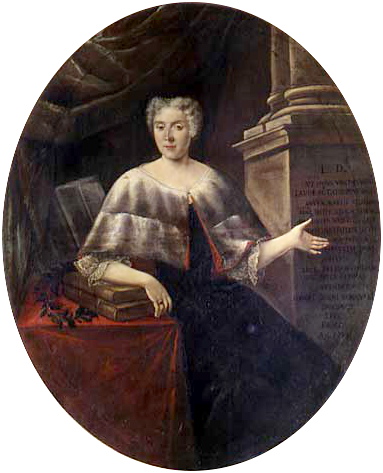Kirsten Walsh writes…
Laura Bassi (1711-1778) had a remarkable career. In eighteenth-century Italy, it was rare, but not unheard of, for a woman from a wealthy family to receive a higher education, a doctorate, or even a lectureship. But what made Bassi unique was how she used her positions at the University of Bologna and the Academy of Science (which would ordinarily have been symbolic) to contribute to the scientific community of Europe.
Thony Christie over at The Renaissance Mathematicus recently wrote a very good post about Bassi’s life and career, so I will not go into those details here. Instead, today I’m interested in Bassi as an eighteenth-century Newtonian and experimental physicist.
 Over the course of her career (roughly 1732 to 1778), Bassi presented papers on mathematics, pneumatics, fluid dynamics, mechanics, optics and electricity. Most of these papers have been lost, but the few surviving papers display Bassi’s talent for mathematics and her commitment to the Newtonian method (as exemplified by Principia). For example, in her paper on differential calculus (“De problemate quodam mechanico”, 1757), Bassi dealt with the problem of how to determine the motion of the centre of mass of two or more bodies moving along any curved paths in a plane. In this paper, she followed the Newtonian method of avoiding metaphysical and empirical assumptions about the nature of matter.
Over the course of her career (roughly 1732 to 1778), Bassi presented papers on mathematics, pneumatics, fluid dynamics, mechanics, optics and electricity. Most of these papers have been lost, but the few surviving papers display Bassi’s talent for mathematics and her commitment to the Newtonian method (as exemplified by Principia). For example, in her paper on differential calculus (“De problemate quodam mechanico”, 1757), Bassi dealt with the problem of how to determine the motion of the centre of mass of two or more bodies moving along any curved paths in a plane. In this paper, she followed the Newtonian method of avoiding metaphysical and empirical assumptions about the nature of matter.
From the 1740s onwards, Bassi and her husband Giuseppe Veratti became very interested in electrical phenomena. Here, we can identify two different Newtonian themes. Firstly, their research appears to have been heavily influenced by the later queries of the Opticks, which attempt to link phenomena such as light, heat, electricity and magnetism with biological phenomena such as muscle movement, growth of plants and phosphorescent fish. Secondly, they supported Franklin’s electrical-fluid theory, which had been systematised in a Newtonian framework by Beccaria.
In the late 1740s, Bassi began teaching privately. Bassi and Veratti had a well-equipped physics laboratory in their home, including an electricity machine. This made it possible for Bassi to teach experimental physics in their home. At the University, the philosophical curriculum was essentially scholastic, and at the Institute of Sciences, the courses on experimental physics had a physiological focus (which reflected the interests of the Bolognese scholars, most of whom had medical degrees). Bassi’s knowledge-base, which by then included advanced mathematics, mechanics, optics, and electricity, made her uniquely qualified to teach a course on Newtonian philosophy and Franklinian electricity. In a letter to Scarselli in 1755 she mentioned the popularity of her classes: “The classes have gathered such momentum that they are now attended by people of considerable education, including foreigners, rather than by youths”.
From this brief survey of Bassi’s work, she appears to have adopted many facets of Newtonianism: she accepted and built on Newton’s rational mechanics, but also followed the leads left by Newton in his optical queries. Indeed, in her own time, Bassi was a well-known Newtonian. Algarotti mentioned her several times (although not by name) in his Sir Isaac Newton’s Philosophy explain’d for the use of the Ladies and explicitly presented her as a Newtonian in ‘Non la lesboa’ – his contribution to the book of poems published in honour of Bassi’s graduation. Also, in 1744 Voltaire implicitly compared Bassi with Newton when he wrote:
- Most Honoured Lady: I would like to visit Bologna so that I might say to my fellow citizens that I have seen Signora Bassi, but, deprived of this honour, I trust that I may with justice cast at your feet this philosophical homage in reverence to the glory of her century and sex. As there is no Bassi in London I should more happily enter your Academy of Bologna than the English one, even though it may have produced a Newton.
But what can we say about Bassi’s ‘experimental physics’? The subject-matter was certainly Newtonian, but what about the methodology? On this blog, we have argued that, from the 1690s onwards, the experimental philosophy was approached in a way that emulated Newton’s mathematical-experimental method. Bassi certainly had the expertise to follow the Newtonian method, which raises the question: Should Bassi’s experimental physics be seen as another facet of her Newtonianism, or should we regard it as a more general interest in the experimental method?
Unfortunately, I haven’t been able to find the evidence to answer this question. I’m not even sure if Bassi engaged in any kind of methodological reflection. Does anyone know how I might find out?


2 thoughts on “Laura Bassi: An Eighteenth-Century Newtonian”
There is a biography in German, that I haven’t read, which might be of some help. Beate Ceranski, “Und sie fürchtet sich vor niemandem”: Die Physikerin Laura Bassi (1711 – 17778), Campus Verlag Frankfurt & New York.
Thanks Thony.
Do you know if Bassi’s papers and letters have been published anywhere?
Cheers,
Kirsten